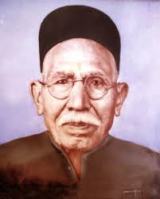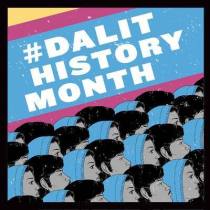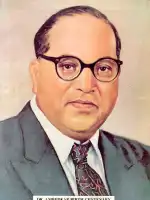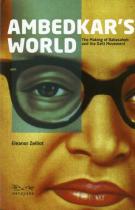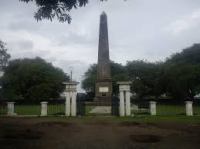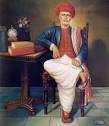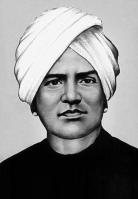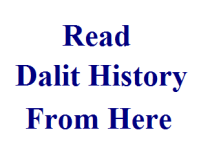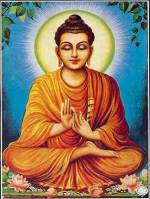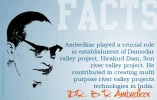Why Science Declined In Ancient India?
By – Dr. K. Jamanadas
A learned medical specialist from Nagpur, in a recent article in lay press, while describing ancient medical sciences in India, has remarked that fall of science of surgery was because of ‘ahimsa’ taught by the Buddha. Though the remark was as an orbus dictum, it shows not only his ignorance of Indian history and of Buddhism, but also desire for making false charges on Buddhism due to, may be, his contempt for the Buddhists. The surgery was never considered ‘himsa’ by the Buddhists, nor for that matter by anybody. Certainly fall of sciences was not because of ‘ahimsa’ of the Buddha.
Modern science is undoubtedly a contribution of the west. That way, in all societies, there were attempts of obstruction to progress of science. In India they got more success. There was a time in Indian history when Indian science was not only famous in the country, but it was so all over the world. If the progress of Indian science would have been maintained unhindered after the sixth century A.D., we Indians, today, would have been foremost in the scientific field.
Golden era of Science in India
From the ruins of Harappa and Mohenjodaro, it is clear that there existed a pre Aryan urban civilization of Dravidians, which went by the name of Nagas. It shows great development of town planning, water supply and urban facilities, sanitary drainage and granaries.
Gold used for ornaments in Harrapan culture was from Kolar gold mines, the only source available, which is proved by a committee of metallurgical experts under sir Edwin Pascoe, who performed chemical analysis, under the direction of Sir John Marshall. So gold mining was a flourishing industry of the time. This also shows the communicating links between south and north, Vindhyas and forests of Dandakaranya were no bar.
The copper used in Harrapan civilization was imported from Rajputana, and tin from Hazaribagh. It used various types of stones quarried all over India, and some imported from outside.
The modern number system of 0 to 9 with use of decimal point is the contribution of Indian mathematicians. It spread to Europe via Arab countries.
Mauryan India also achieved remarkable success in fields of Engineering, town planning, architecture and art. India’s first irrigation dam belongs to this era and was aptly called “Sudarshana”, i.e. beautiful in later inscriptions of Rudradamana.
We know the importance of Ashokan pillars for aesthetic beauty, craftsmanship and religious declarations, but it was also known for the science of polishing of stones to such an extent that it became the distinguishing mark, the structures with high polish being ascribed to Ashokan period. Such gloss and polish, Marshall says, “no modern mason can produce”, Vincent Smith calls it “the despair of modern masons”, Tom Coryat and Whittekar described it as of brass, Chaplain Terry as a pillar of marble, and Bishop Heber as pillar of cast metal.
In the first and third centuries A.D., two important texts were composed on medical science, namely Charak Samhita and Sushrut samhita, which show the advanced stage medical knowledge in India.
Susrut Samhita, which is a text of surgical science, describes more than one hundred instruments of surgery. It also describes the plastic surgery procedures, specially the operation of rebuilding of nose, what we today call as rhinoplasty.
At the time of invasion of Alexander, India was famous for medicine and surgery.
In Buddhist books, we find mention of Jivaka who operated on the brain of a merchant. He was appointed by Emperor Bimbisara as a physician for Lord Buddha and cured him of constipation by making use of inhaling fragrance of medication on a lotus flower. The science of Inhalers in modern medicine is pretty recent. He cured diseases of head, a fistula by ointment, jaundice and performed surgery on brain and intestinal “entanglements” as per the Vinaya texts, which Radha Kumud Mukharji calls were “not given to exaggeration like a work of fiction”.
Ashoka had sent medical missions to five Hellenistic States of Europe for humanitarian service, with aushadha, mula and phala, as per Rock Edict 2 and 13.
Education of medicine was compulsory in Nalanda Mahavihara and even I-Tsing had to undergo a course.
Up to seventh or eighth century A.D., Indian physicians and surgeons were respectfully appointed in Baghdad.
Indian medical books were popular in China. A Chinese work composed in 455 A.D., is derived from Indian text. A number of medical books are found in Chinese Buddhist collection. A text on Children’s Diseases, named “Ravana-kumara-charita” was translated into Chinese as late as 11th century.
Indian Medical science and arithmetic was highly valued in the west. Greek and Iranian physicians knew Indian medical texts. It is recorded that Barzouhych, a subject from Sassanid King Khusro I’s court (531-579 A.D.) visited India for study of medicine.
Meharauli iron pillar, which is standing in the courtyard of Kutub Minar at Delhi, belongs to fourth century A.D. It is standing there, defying the ravages of times, for centuries but not a spot of rust or corrosion on it. Its composition was examined by a committee of experts, who held that, it was beyond the capacity of any Iron foundry in the world of that time to manufacture such a masterpiece.
From Periplus we know that the sword made of Indian steel is proverbial in Arabic literature, showing the highest skills and knowledge of metallurgy. The famous Damascus blade was made from Indian steel.
Ancient South Indian bronzes are praised even now in the whole world not only for their craftsmanship but also for metallurgy. Sultanguanj colossal Buddha in copper is a metallurgical masterpiece and a marvel, still preserved in Birmingham museum.
Jawaharlal Nehru describes how the Roman Emperor scolded his daughter for wearing so little clothing on her person, while in fact she was fully clad in Indian made muslin clothing, showing the high degree of skill in textile industry.
It is recorded that, “the Roman beauties, decked in even seven folds of Muslin, and parading themselves on the highways of Rome, became a menace to its morals.” and import of Indian textiles had to be banned by Roman Parliament. The ban on imports was necessary also because of balance of payment crisis. Pliny estimates one million pounds sterling drain per year. It resulted in favourable trade balance for India, with a stable gold currency for the Kushana empire.
India was also famous for paints and dyes, which were the products for export. The pictures of Ajanta are famous not only for aesthetic beauty, art and history but also for quality of paints and pigments used.
The science and art of ship building suffered most during “kali varjya”. The sea worthy people of south India were great voyagers. They built ships of huge tonnage, traveled to far east, established settlements, colonies and even kingdoms and propagated their faith both brahmnic and Buddhist. All these qualities became futile after imposition of ban on sea travel.
Dhanvantari
In the medical field, the scholars of present time, seem to have forgotten about Jivaka, Nagarjuna, Sushruta, Charaka and Vagbhata. They appear to give more importance to Dhanvantari. The picture presented of him is not as a medical teacher, but as an imaginary mythological puranik god who sprang up from the churning of ocean of milk by the devas and danavas. Why the former historical dignitaries are ignored in preference to him will be clear if we bear the fact in mind that all leading names in ancient medicine were Buddhists. So they had to invent a god for Ayurveda.
However, there is a minor medical work going by name of Dhanvantari. It is a Nighantu or a medical dictionary. It is mentioned in Amarkosha, and hence in original form must have preceded the Amarkosha; but its extant form it must be ascribed to a later date. Amar, writer of Amarkosha, was according to tradition one of the nine jewels at the court of Vikramaditya, whose very identity it has not yet been possible for scholars to fix beyond all doubt. He is “known as a poet, and was certainly a Buddhist who knew the Mahayana and used Kalidasa”, as per Winternitz, His date is uncertain but he probably flourished before the eighth century A.D.
Aryabhatta
Aryabhatta, born in 476 A.D., flourished in the centre of Buddhist heart land, i.e. Capital of Magadhan empire, at Pataliputtra. and his Aryabhatiya was composed in A.D. 499. He was first to treat Mathematics as a distinct subject and he dealt with evolution and involution, area and volume, progressions and algebraic identities, and intermediate equations of the first degree. He also arrived at a ‘remarkably accurate value of PI, viz. 3.1416’
Aryabhatta was also the first to hold that the earth was a sphere and rotated on its axis. For this, he gave a beautiful analogy that to a person travelling in a boat, trees on the shore appear to move in oppoite direction, similarly because earth is rotating on its axis towards east, it appears to us as if the sun moves from east to west. He also explained that the eclipses were not the work of Rahu and Ketu or some other ‘rakshasa’, but were caused by the shadow of the earth falling on the moon. As we will see later, both these views were rejected and severely condemned by later astrologers like Varahmihira and Brahmagupta.
One of the most important features of Aryabhatta’s mathematical system is his unique system of notation. It is based on the decimal place value system, unknown to other ancient people, but now in use throughout the civilized world. Whether Aryabhatta invented the system or merely improved on an existing one cannot be definitely stated. But with the doubtful exception of Bakhshali manuscript, which is referred by some to c. A.D. 200, the earliest use of the system occurs in Aryabhatiya, and it is found in all later mathematical works.
Thus till that time, which was the golden era of Buddhism and decline had yet to start, India was in no way inferior or behind any other country of the world, in the field of science.
Buddhist rulers and science
In third fourth century B.C., in the Asokan times, there was great advances in veterinary science. For treatment of elephants, “Palkapya samhita” and for treatment of horses, “Shalihotra samhita” were written. We find in his edicts, mention of hospitals established by him for men and animals even in far off places in south India. All this shows the growth of Veterinary science in India.
All these show that Indian science was well advanced up to sixth century. One has to ponder over what were the reasons which not only obstructed the progress of science, but also destroyed what was already achieved. One has to understand the history, literature and puranas, and social conditions to find these out.
It is clear from the dates, that the age of progress of science in India was the age of glory of Buddhism. Acharya Charak was the ‘rajvaidya’ in the court of Buddhist emperor, Kanishka, of first century A.D. Buddhist philosopher Nagarjuna was also their contemporary. He was also famous physician. The contribution of Charak to “Charak Samhita” is as important as Nagarjuna’s contribution to “Sushrut Samhita”.
Whatever knowledge of ayurveda was being spread through the oral traditional method of Guru sishya teaching was revised and reduced to writing in the times of Buddhist rulers.
During the early centuries of Christian era, medical science was on zenith. In this development, the contribution of Buddhists was enormous. Through them, the knowledge spread all over the other foreign countries.
Role of Buddhist faith
As a matter of fact, science spreads only when it is free from the fetters of traditions. Lord Buddha had given that freedom to Indian society, that freedom of thought and action. Liberated from the severe caste rules, society was taking keen interest in progress of scientific pursuits.
Jivaka, discussed above, was an infant found on a dung heap, and still could reach such an illustrious position, only because of Buddhist environment. We know in brahmanic tradition, admission to school was based on caste as is seen by examples of Karna, Ekalavya and Satyakama Jabaala.
The situation was quite opposite in Brahmanic teaching institutions, In Brahmanic Gurukulas, there were no criteria for admission apart from the caste of the prospective student and whims and fancies of the teacher. Examples of denial of admission to very meritorious candidates on the basis of caste are seen. Glaring example is of Eklavya. Not only the guru Dronacharya denied admission to Eklavya, but demanded Eklavya’s thumb as gurudakshina for education NOT imparted by him. Many people feel it is irony of fate and mockery of awards, that such a name is associated with highest sports awards in this country today, without any protest from the sufferers of the system.
Second example is of Karna, who got admission to Parashurama’s class, which was exclusively reserved for the brahmins, on false statement of caste. Benefit of his knowledge, labeled as unlawfully obtained, was withdrawal when his caste became known, which ultimately lead to his death.
Example of Satyakama Jabala is mentioned by many orthodox people to erroneously show that education in Upanishadic times was open to low caste people. This is a wrong inference drawn from his story. Satyakama was asked by his guru his caste. His mother sent a word to the guru that she did not know the exact father of the child as she had relations with many people. This frank statement, the guru declared, can only be a statement of a son of a brahmin. So the admission to the gurukul was done on the basis of brahmin caste. Not only that, the test applied by him, and his presumption of brahmin caste, was derogatory to non- brahmins, because it was his belief that only brahmins could speak such a truth and non-brahmins could not have uttered such truth.
Buddhism and Science
Kurt F. Leidecker, President Buddhist Center of America, and others very aptly observe in “Buddhism and Science”,
” Perhaps one reason (for progress of science) is that Buddhist thinking has always enjoyed the greatest freedom untrammeled by dogmatism and authority of any kind, not even that of Buddha himself. We have his words in the Kalama Sutta which should be given in the hands of any who write and pronounce judgment on Buddhism.”
“Science observes, describes, establishing the truth on ocular demonstration and verification by experiment which anyone may undertake without the least faith in ultimate results.”
“Whatever progress has been made in the western world in science and technology, was made not because of faith and belief in supernatural, but largely by rejecting it or being indifferent to it.”
“Science is based most assuredly on analysis, that is, scrutinizing every phenomenon and examining every part of it and finding out how it came about. That is exactly what the Buddha did.”
“The fact is that in the history of Buddhism there has never been any altercation with scientists, and no war has ever been declared on science. Warfare between science and Christianity? Yes, there has been too much of it. Warfare between science and Buddhism? Never.”
Crusade against Science
There were wars against science in the western world also. But it is in India that the antagonists of science won the war. Brahmins opposed Buddhists, and their relations were so strained on the issue of caste supremacy, that they became bitter enemies of each other. They opposed every thing in which Buddhists were experts, even the science. Dr. Ambedkar very rightly said, “It must be recognized that there never has been a common Indian Culture, that historically there have been three Indias, Brahmanic India, Buddhist India and Hindu India, each with its own culture. It must be recognized that the history of India before the Muslim invasions is the history of a mortal conflict between Brahmanism and Buddhism.”
In the far off counties, the Buddhists were getting name and fame, but at home in India, there were efforts to dig out and uproot their moorings. Later when Buddhist became weaker due to internal differences and contradictions, the brahmins put themselves in citadel, in which the new arrangements were made by which they declared as inferior and degraded all those things, which Buddhists were good at and for which Buddhists were famous for all over the world.
Even science was not spared from this fate. A famous scientist of modern India, Dr. Neelaratna Dhar aptly observes that, the progress of science was obstructed by the decline of Buddhism in India. The help and support received from Buddhist Universities and monasteries to chemical and medical sciences in the hospitals was stopped. After the fall of Buddhism, Brahmins dominated and they denounced, condemned, denigrated and maligned all those things in which the Buddhists had excelled.
In the fight against the Buddhists, kali varjya was clamped on this society. Hinduism got rearranged, and in its new concept, foreign travel was forbidden. All vocations relating to science were declared sacrilegious, blasphemous, heretical and disrespectful. Caste rules, rules of high and low, rules of untouchability and inequality all were made more and more strict. All knowledge and science was made more secret, secluded, hidden and concealed and every new thought and invention was opposed.
Due to ban on travel to foreign lands, India got cut off from the rest of the world. The society was not like a frog in the pond, before; but due to severance of bonds of communications with the outside world, the stupid injunctions of priests became the words of authority. There is a phrase in Marathi saying, whatever priest tells is east and whenever he says is the new moon day. In such circumstances, it was natural that all scientific progress got suffocated.
The various vocations were graded according to basis of caste hierarchy, white collar jobs were kept by higher castes and the rest of population, the shudras i.e. the working class, the marathas or kunbis, the malis, the telis, the gawalis, the lohars, the sutars, the mangs, the mahars, the chamars, the paradhis, the gonds, the bhils etc. etc. all ‘shudras and ati- shudras’ in Mahatma Phule’s terminology and ‘bahujans’ in todays terminology, were made the beasts of burden to carry out all activities requiring toil and sweat. By this the prestigious castes lost all links with practical aspects of technology and means of production. All niceties of life, food clothing housing and attendant luxuries, wealth, comfort, and prosperity was concentrated in the hands of three varnas, and to provide these the shudras had to toil and sweat their blood out. All the productive work which is done in western countries by choice, option and preference was done in India as a burden, a charge, an obligation, a stress through a feeling of frustration and pressure of compulsion due to ‘purva karma’, the deeds of past life. The society was made to believe that those people who do not work with their hands are more civilized, sophisticated, cultured, noble, dignified and worshipable, and have attained that position because of the good deeds they had done in the past lives; the good deeds meant, of course, the preservatin of chaturnarna.
Lord McCauley, some times, is unnecessarily blamed for creating the army of white collared babus. The reality is that this germ of white collared arrogance was already in this soil.
Role of Mahabharata
In this important text of Hinduism, medical science, architecture, manufacture of weapons, painting, sculptor, agriculture and animal husbandry has been condemned time and again. In one place it is even said that, the food given to a vaidya, i.e. a physician, in a shraaddha becomes unacceptable to the pitars like blood and pus. It is clear that till the time of Mahabharata all these vocations were declared mean, contemptible, lowly, humble and ignoble.
There are three types of treatments in ayurveda, they say. Where rasas are used is ‘daivi’, where fruits are used is ‘manushi’ and the surgery, some modern authors say, was a ‘aasuri or rakshasi’ knowledge. This is the brahmanic interpretation of later times. If similar sentiments prevailed in the earlier times we would not have seen the prosperity of surgical knowledge at the time of Jivaka and Sushruta etc. Because of this feeling, surgery was despised and hated more and more and so it went to hands of the lower castes in the society.
It is said by Dr. Satya Prakash that science of obstetrics and maternity surgery was well developed at the time of Sushrut. When none in the outside world could think of surgical instruments, Sushrut describes various operations of maternity with these instruments. His advises about maternity are similar to modern ones.
The famous Jivaka of Buddha’s time, was expert in maternity science. He was called Kumar Bhrutya Jivaka. Till the Buddhists dominated, the art and science of maternity in ayurveda flourished. After the fall of Buddhism, when brahmins dominated, they declared this science as dirty and it passed on to the women of low castes. It remained with them till the British came, and still in villages these dayees of low castes, i.e. midwives, prevail even today.
The feeling of high and low was so great in the Brahmanas, that even the gods had been divided into castes, high and low. Ashwani kumars were declared shudra gods, not eligible to take part in drinking soma by Indra, who was considered ksatriya. As they were physicians, this profession degraded them to the status of shudras.
In west, all the scientist were sons of ordinary working class people, like carpenter, blacksmith, cobbler, barber etc. These professions were never considered degraded. With us, the working class was always degraded castes. If they had been given some encouragement and motivation in technological fields, science in India would have flourished.
The science develops by spread of thought, but in India, there was more of secrecy to guard it from lower castes. Nobody having any useful knowledge wanted to part with his knowledge. It was within Guru and his disciple to start with. When writing came in, around beginning of Christian era, the texts were written in such a script that they were understood by only a few. Example of Varahmihir can be quoted who ordained that only selected disciples should be given such knowledge, and see that it does not pass even to his son. How much knowledge is lost in darkness, nobody can guess.
Science deals with physical world, but we were taught that world is unreal only the god was real. This raised the armies of sadhus, who were interested in philosophy and bhajan kirtan and their subject was in the world here after. They were not interested in science as world was ‘mayajal’ for them.
With perhaps a solitary exception of Bhaskaracharya of 12 to 14th century, there was not a single activity in the sphere of scientific knowledge, roughly from sixth century, up to 19th century when the British came,
Some people like to blame Islam for this decline in science. It is wrong to say so. Decline had started much before the Muslims came. We became slaves afterwards, we were withered and wrinkled much before that time due to our internal weaknesses. The reasons of decline of science in India are also the reasons for its defeats and political fall and are responsible for the slavery, this land suffered for centuries.
Creation of Illiteracy
India is supposed to have largest number of illiterates in the world. Many institutions are fed on State revenue for the ‘noble’ cause of so called ‘adult’ literacy. But nobody tells us why India remained illiterate for centuries. It was Dr. Ambedkar who brought this fact in light. He averred that, without formal education the accumulated thought and experience relating to a subject can not be learned by a student and he will not get new perception and his horizon will not widen. This requires schools, books and planned materials and literacy. Formal education was confined to study of to Vedas alone, in schools meant only for brahmins, as they propagated that there was no knowledge outside Vedas. Education of rest was neglected by the state. Children of vaishyas learned rudiments of business geography and arithmetic from fathers in course of business, and so did the shudra craftsmen from their parents. This education was domestic and practical. Due to this illiteracy became inherent part of Hindus. Manu and others made laws to this effect. Those who had right to study the Vedas had right to read and write, others were deprived of this right. So according to laws of Manu, reading and writing has become the right of few high caste men and illiteracy has become the destiny of low caste multitudes. This is how literacy was prohibited and general ignorance prevailed among the masses.
Fate of Aryabhatta
One need not confuse between astronomy and astrology in ancient India, because both went by the name of ‘jyotisha’. If the study of astronomy would have progressed in normal way, we would have achieved tremendous progress in space technology. But the blind faith in stars and imaginary ‘loka’s led to ruin of this science.
We know that Vedas declare that earth is stationary and sun is moving. We know the word ‘achalaa’ for earth, we also know the horses for the ‘ratha’ of sun. In spite of such ideas in Vedas, astronomers like Aryabhatta in fifth century declared, as mentioned above, that earth is moving and sun is stationary, and explained how lunar and solar eclipses take place. The priestly class saw danger to their livelihood, if Vedas were found fallible. They organized a crusade against Aryabhatta, in two ways.
Brahmagupta (c. 598 A.D.) criticized and asked, if earth is moving, where is it going to and by which way. Varahmihir (c. 600 A.D.) wrote, if earth is moving the birds would not reach their nests in the evening. If the earth is rotating fast towards east, the flags would always fly towards west, and if it is rotating slowly, it would not complete rotation in 24 hours. Same arguments were repeated by another acharya, Lallacharya in seventh eighth century. He also said if earth moves towards East, the arrow shot in the sky would fall on the West and that the clouds would move West. If earth is moving slowly, how would it complete rotation?
Even Bhaskaracharya (some time between 1114 and 1400 A.D.) totally denied that earth can move. He said Earth is fixed. As Sun and fire are hot, as Moon is cold, as water flows, as stone is hard, similarly it is natural that earth is fixed. So much so that word ‘achalaa’ became a alternate term for earth.
Thus Aryabhatta was ridiculed and criticized with wrong logic. Not only that, but in 10th century a fraud was committed, a fake copy of ‘Aryabhatiya’ was prepared declaring earth as ‘achalaa’, and later it was declared that this is his real text of Aryabhatta. The fraud is clear as the real point is, if Aryabhatta had originally said, in the first place, that earth is ‘achalaa’, why was he ridiculed, condemned and denounced for about five hundred years.
Thus astronomers, or so called ‘jyotirvids’ were denounced from all angles whenever opportunity presented. They were declared mean, lowly and contemptible, they were declared polluted, they were denied all respect and their means of livelihood were withdrawn. They were prohibited from being called to yadnyas, mahadanas and shraadhas. The rearer of goats, painters, vaidyas and watchers of stars must not be respected though they might be learned like a brahaspati, so says Atrisamhita. Mahabharata says those brahmins who study the stars must not be allowed to sit in the line with for meals in shraadha. (Anushasan parva, 90, 11/12) Manu III. 172, 167 declared those as lowly, contemptible and unfit for yadnas and shraadha. Nirnaya sindhu 3, and Vivek sindhu 3, also declare them unfit for being called in yadnyas and shraddha. They are also condemned and ridiculed by Brihit samhita (2-2).
These ‘daivadnyas’ not only deceived the masses but also the rulers, and condemned the ‘jyotirvids’. They were cunning and talked glibly. Varahmihir says, he should be clever, bold, quick witted, irrepressible, smart and shrewd. They were very near the political powers and so nobody could touch them.
Still the public respected the jyotirvids, so the brahmins changed the meaning of the word jyotirvidya, which now meant those who study the ‘effects’ of stars on human beings contrary to the original meaning of study of stars, and themselves became ‘daivaidnyas’, – the knowers of fate. This stopped the progress of astronomy which died a natural death.
Not only that, daivadnyas later declared the means of controlling and changing fate by shanti, mantras and yadnya etc. Varahmihir describes the many qualities for daivadnya, like shantik – mantras for removing calamities, poustik – mantra for increasing health wealth etc., abhichar – means of punishing the enemies.
Still the common people criticized these fortune tellers. So they declared such critics as ‘nastika’, ‘mlencha’, ‘chandala’ etc. and pronounced them of ‘sankara yoni’. This stopped all progress of astronomy. Everybody knows that ‘varna sankara’ is a big abuse of ancient India, and a greatest punishment in civil life. These people were boycotted and were compelled to lead an isolated life of a beast.
Thus astronomy or mathematical Jyotish was driven away by the ‘falit’ jyotishya, which provided bread and butter to brahmins and is still doing it. This ‘falit’ jyotishya has made Indians mere fatalists. Whereas in other countries, everybody exerts his own effort to change the unfavorable surrounding environment, we, in India, are more in search of Rahu and Ketu. Even today, the same thing prevails, and we find the dignitaries changing the direction of entrances to their residences and timing the oath ceremonies to match the timings of the stars. For the first time after centuries, Aryabhatta was honoured by Indian scholars, when the first ever Indian satellite was sent to orbit was named after him.

Why only science suffered
Dr. Gorakh Prasad writes that after Bhaskaracharya, it was considered a sin to make any progress. To find errors in old texts and correct them and to search for new things was totally banned. When such a thing was brought up, the brahmins of Kashi opposed vehemently.
Some people unburden themselves by putting blame on ‘foreigners’, meaning Muslims, for this fall of science, but history tells us that our other activities, other than science, did not change much. Why only science suffered? Not that we had no scholars. There were fights, disputes and clashes in ‘shastrartha’. The very word ‘shastrartha’ applied to debates, denotes that no new facts are to be discussed, whatever is to be discussed must be to find the real ‘artha’ i.e. the meaning, of the old ‘shastras’.
The philosophical texts abounded by constant churning. Puranas and smritis were compiled, edited and reedited. Various commentaries were written amending old laws. And a lot of discussion took place on poetry. The literary innovations of metre and rhyme is plentiful in the drama and poetry of the time, and the intricacies of art and ‘alankaras’ were invented, which no other country has done. Poets and scholars spent their effort and capacity in observing most minute details of female anatomy and portraying it in texts, and such poets are compared with literary merit of Shakespere. Then why this ban on science alone?
The reason becomes apparent when you view the society in proper perspective. The society was divided into six thousand castes, all placed one above the other, with brahmin at the top, who also did every thing to maintain its supremacy. The real reason of fall of science was that, the science and technology brings comfort to common masses, which our acharyas did not want. They were self centered in their own domination over the masses and their Rajput – ksatriya masters were after life of comforts and luxury throughout the period of alien rule. The threat to these comforts was considered danger to the ‘dharma’. It might be an interesting subject for study, as to what were the various things which were considered as ‘danger to dharma’ in course of our history. If these gods on the earth and their disciple rulers would have thought of broader welfare of masses, and incorporated these problems in their agenda, the science would not have suffered, neither the country would have been slave for centuries under a fistful of individuals of alien faith.
































